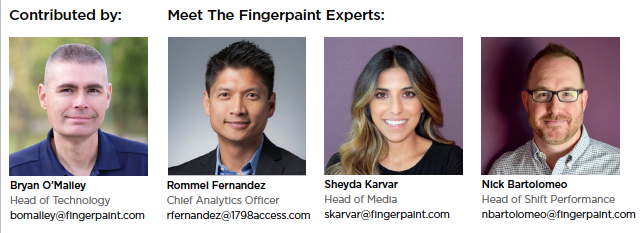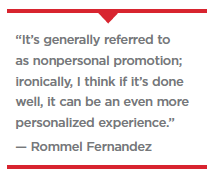 Innovative technology has been driving high-touch experiences for decades. Artificial intelligence, machine learning, and advanced analytics are the latest advancements to help marketers reach customers and drive performance.
Innovative technology has been driving high-touch experiences for decades. Artificial intelligence, machine learning, and advanced analytics are the latest advancements to help marketers reach customers and drive performance.
The pandemic further accelerated their adoption, and healthcare marketers are leaning even harder into these areas and the realm of big data to push the boundaries of brand marketing.
I’ve gathered a few of my fellow Fingerpaint digital leaders — Rommel Fernandez, chief analytics officer; Sheyda Karvar, head of media; and Nick Bartolomeo, head of Shift Performance — for a frank discussion on how the landscape has evolved and what the future of digital marketing in healthcare for biopharma companies will look like.
Bryan: How has the past 18 months changed the future of digital marketing?
Rommel: The past 18 months has accelerated where we have been heading in relation to digital initiatives towards a path of less in-person interactions. It’s generally referred to as nonpersonal promotion; ironically, I think if it’s done well, it can be an even more personalized experience. By using data, we can know so much more about the person we are trying to reach and can tailor each interaction to their specific needs and interests.
Nick: There is more pressure than ever on the sales and marketing teams to create meaningful engagements with HCPs. In many ways, COVID has accelerated the need and growth of a data-driven, omnichannel environment. Our proprietary Shift Performance platform, which uniquely orchestrates the omnichannel experience across marketing and sales, already had us well-prepared.
Bryan: How will what is happening in the industry impact a company’s salesforce?
Nick: Pharma is a kind of unique industry in that sales reps could walk into a doctor’s office and sort of demand their attention. But the pandemic changed that, requiring reps to be more resourceful — by taking advantage of the multitude of signals across the omnichannel experience. This digital body language can be interpreted to determine things like call priority and next-best content to deliver, arming reps with information to make real-time decisions.
Bryan: It’s a great point, and you can’t do this without data, analytics, and a well-targeted media strategy.
Why does someone open one email and not the other? Leveraging robust data sets allows us to understand their interests and needs, providing the insights required to craft more impactful messaging and design content that is more appealing and relevant to that person.
Sheyda: Exactly. From an HCP media perspective, we bring together multiple data sources to understand factors like patient count, channel preference, and willingness to trial in order to identify high-priority targets and trigger messages that are relevant and timely.
Reps can’t be everywhere, so we use media to serve HCPs a personalized, data-driven message based on their unique journey. Then, we use their engagement data to understand when they are ready for a more personal touchpoint and feed that engagement data to the rep so they are equipped to give the next best message.
Rommel: In addition, it’s no longer about just the healthcare provider. Data are allowing us to get more knowledge about the people they treat and who they support. Looking at the broader ecosystem of care, we can tailor the messaging to those needs. If I am well-informed about the type of patients they treat and what their needs are, I will be more effective in my goals as a sales rep.
Bryan: So, the fundamentals haven’t changed, but the need for relevance and data has increased.
Rommel: Before we can just talk about data and their relevance, we should also consider the application of analytics. Analytics can mean many things to a lot of people. I think of it in terms of whether it’s descriptive, predictive, or prescriptive. Data and analytics will help provide us the insights to make meaning decisions or gain more relevant perspectives, which is always the intent.
Bryan: How do you become more efficient with what you’ve got?
Sheyda: Predictive models. We know the patient journey for a rare disease diagnosis is a long one, with the average time to diagnose extending between 5.6 and 7.6 years, according to experts. By understanding all the touchpoints — misdiagnosis, tests, failed treatments — and building predictive models based on the paths to diagnosis and treatment, we can initiate messages to HCPs who are taking similar actions. These messages can be educational about the disease state, suggest ordering a test, or promote a treatment option based on where the HCP is in the journey. Marrying together creative messages with data triggers is the sweet spot.
 One trend that the pandemic accelerated is timeliness. And we can use data to influence the timeliness of our message. Whether it’s leveraging programmatic to serve an audio spot in the middle of the night for an insomnia product, or advanced content recognition to trigger a banner or social message on a user’s second (or third) device to drive an onsite conversion for someone watching your TV spot, audiences simply want the most appropriate message in the most digestible format.
One trend that the pandemic accelerated is timeliness. And we can use data to influence the timeliness of our message. Whether it’s leveraging programmatic to serve an audio spot in the middle of the night for an insomnia product, or advanced content recognition to trigger a banner or social message on a user’s second (or third) device to drive an onsite conversion for someone watching your TV spot, audiences simply want the most appropriate message in the most digestible format.
Rommel: In the U.S. healthcare system, there can be so much data both syndicated as well as publicly available. Those who figure out which data to pay attention to will be the ones that will be in the lead or one step farther, or faster, than the competition. The key to winning is going to be how you stitch it all together.
Bryan: You bring up a great point about stitching it all together. How do you integrate data across a myriad of channels and platforms?
Rommel: A lot of the data today are siloed, and they are not coordinated. It starts with breaking those silos down. So, those who know how to integrate both from a technology and a process perspective to gain insights will lead the way.
Sheyda: There’s strength in being integrated and having our roots in creative. We see a lack of connectivity and even efficiency when this isn’t the case. Each stakeholder, understandably, has their own priorities, but by coming together at the start of a project, we can develop a holistic strategy that encompasses channels, audiences, and influence. Who are we trying to reach and what is the desired action, and what’s the best channel and message combination that will achieve those goals?
Nick: When the teams are not integrated, creativity gets diminished, and performance and innovation — especially media innovation — suffer. Having it all integrated under one roof helps us measure everything back and ladder it up to their business impact: what it means in terms of scripts and sales. The importance of measurability and driving impact is really at the heart of what makes the difference.
Rommel: The pandemic has forced us to rely on technology a lot more, but that doesn’t mean that you should be all technology and no human interface. You could have all the data in the world, but you can’t apply those data without context. You still have to know what they’re telling you.
You are trying to connect with people from different cultures and ethnicities to build empathy, which is a huge challenge. Most companies still don’t do it very well, and there’s a need for it.
We use tools like machine learning to sort the data and make predictions but use human intelligence and our collective experience to react to that information and inform the work we are doing to create meaningful content and context.(PV)
Fingerpaint is biopharma’s commercialization partner for analytics-enabled integrated solutions. At its core, Fingerpaint is an award-winning global team of more than 580 people who are committed to creating and executing meaningful brand experiences for healthcare providers, care partners, and patients.
Learn more at www.fingerpaint.com.



















